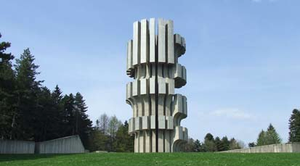- Battle of Kozara
-
This article is about the World War II battle. For other uses, see Kozara (disambiguation).
Battle of Kozara Part of the Yugoslav Front of World War II
Battle of Kozara MemorialDate June - July, 1942 Location Kozara mountain, northwestern Bosnia Result Axis victory; Partisan force severely damaged Belligerents Axis:
 Germany
Germany
 Independent State of Croatia
Independent State of Croatia
 Hungary
HungaryAllies:
 Partisans
PartisansCommanders and leaders  Friedrich Stahl
Friedrich Stahl Josip Broz Tito
Josip Broz TitoStrength some 15,000 German troops
22,000 Independent State of Croatia troops
5 Hungarian monitors3,000 troops aided by local volunteers and recruits The Battle of Kozara, also known as Operation West-Bosnien by the Axis, was fought in 1942 on and around the mountain of Kozara in northwestern Bosnia. It was an important battle of the Yugoslav Partisan resistance movement in World War II. It later became an integral part of Yugoslav post-war mythology, which celebrated the courage and martyrdom of outnumbered and out-gunned Partisans and civilians.
Certain sources mistakenly identify the Battle of Kozara as the Third anti-partisan offensive.
Contents
Background
In the spring of 1942, Yugoslav Partisans in central and west Bosnia liberated Bosanski Petrovac, Drvar, Glamoč and Prijedor. On May 20, the 1st Krajina Assault Brigade was founded, and the next day it obtained tanks and a modest air force. The free territory stretched from the river Sava south across the mountains Kozara and Grmeč. During the winter, Partisans inflicted heavy casualties on the Germans. Great loss for Partisans was death of their capable and distinguished commander, Mladen Stojanović, known as "Komandant Mladen", who was killed in March 1942, by the Chetniks of Rade Radić.
The German and Ustaše authorities realized that the city of Banja Luka and the iron mine in Ljubija were in danger and organized an offensive to destroy the movement. Germans engaged 15,000 soldiers, the Independent State of Croatia (the Ustaše) about 22,000 soldiers, Chetniks about 2000 soldiers, and Hungarians participated with 5 monitor ships.
The Partisan group had about 3,000 soldiers, but recruited reserves from the 60,000 civilians in the free territory.
After intensive battle, in the night July 3 some partisan units broke the siege, but the main group again came under siege the next night and was mainly destroyed. In Široka Luka about 500 wounded Partisans were killed. It is estimated that during the battle, the Partisans lost about 1,700 soldiers, while the Axis forces lost about 7,000. During and after the battle, many thousands of Serbian civilians from Kozara were sent to the Ustaše Jasenovac concentration camp.
About 900 Partisan soldiers survived and founded the Fifth Krajina Brigade.
At the same time, the main Partisan group with Josip Broz Tito moved from East Bosnia to West Bosnia. After the Axis offensive forces withdrew, parts of lost area were regained in September 1942.
Approximately 25,000 Serbs were killed in the operation, mostly in concentration camps.[1]
See also
- Yugoslav Partisans
- Yugoslav Front
- Croatian Armed Forces (NDH)
- Military history of Croatia
- Resistance during World War II
- Anti-partisan operations in World War II
- Kozara National Park
References
External links
Yugoslav Front Overview Participants People 1941:
1942:
- Second Offensive
- Third Offensive
- Battle of Kozara
- Operation Kopaonik
1943:
- Battle of the Neretva (Fourth Offensive)
- Battle of the Sutjeska (Fifth Offensive)
1944:
- Sixth Offensive
- Raid on Drvar (Seventh Offensive)
- Operation Halyard
- Belgrade Offensive
- Kosovo Operation
1945:
- Syrmian Front
- Battle on Lijevča field
- Bar massacre
- Battle of Poljana
Macedonia:
Strategic bombing:
 Partisans
Partisans
 People's Liberation Army of Macedonia (Partisan faction in Macedonia)
People's Liberation Army of Macedonia (Partisan faction in Macedonia)
 Soviet Union (limited involvement, 1944-45)
Soviet Union (limited involvement, 1944-45) Bulgaria (limited involvement, 1944-45)
Bulgaria (limited involvement, 1944-45) National Liberation Movement (limited involvement, 1944-45)
National Liberation Movement (limited involvement, 1944-45)
 Royal Yugoslav Army (limited involvement, 1941)
Royal Yugoslav Army (limited involvement, 1941) Chetniks (nominally Allied, lost official Allied support in 1943)
Chetniks (nominally Allied, lost official Allied support in 1943)
 Germany
Germany Italy (1941-43)
Italy (1941-43) Albania (1941-44)
Albania (1941-44) Hungary (1941-44)
Hungary (1941-44) Bulgaria (1941-44)
Bulgaria (1941-44) Independent State of Croatia (NDH)
Independent State of Croatia (NDH)
- Croatian Armed Forces (HOS)
- Ustaše Militia (including the Black Legion)
- Croatian Home Guard
- Air Force of the Independent State of Croatia
- Croatian Air Force Legion
 Serbia under German occupation
Serbia under German occupation
- Serbian State Guard
- Serbian Volunteer Corps
 Pećanac Chetniks
Pećanac Chetniks- Russian Corps
 Slovene Axis supporters
Slovene Axis supporters
- White Guards
- Slovenian Home Guard
- Legion of Death
- Upper Carniola Home Guard
- Slovene National Security Force
 Montenegro
Montenegro
- Lovćen Brigade (Zelenaši movement, 1942-44)
- Montenegrin People's Army (former members of the Chetnik movement, 1945)
 Josip Broz Tito
Josip Broz Tito Milovan Đilas
Milovan Đilas Aleksandar Ranković
Aleksandar Ranković Kosta Nađ
Kosta Nađ Peko Dapčević
Peko Dapčević Koča Popović
Koča Popović Petar Drapšin
Petar Drapšin Svetozar Vukmanović Tempo
Svetozar Vukmanović Tempo Arso Jovanović
Arso Jovanović Sava Kovačević †
Sava Kovačević † Ivan Gošnjak
Ivan Gošnjak
 Draža Mihailović
Draža Mihailović Ilija Trifunović-Birčanin
Ilija Trifunović-Birčanin Dobroslav Jevđević
Dobroslav Jevđević
 Maximilian von Weichs
Maximilian von Weichs Alexander Löhr
Alexander Löhr Edmund Glaise von Horstenau
Edmund Glaise von Horstenau Mario Roatta
Mario Roatta Ante Pavelić
Ante Pavelić Dido Kvaternik
Dido Kvaternik Milan Nedić
Milan Nedić Kosta Pećanac
Kosta Pećanac Sekule Drljević
Sekule Drljević Leon Rupnik
Leon Rupnik
Categories:- Conflicts in 1942
- Yugoslavia in World War II
- World War II Eastern European Theatre
- Battles involving Yugoslavia
- Anti-partisan operations of World War II
- Battles of World War II involving Germany
Wikimedia Foundation. 2010.

